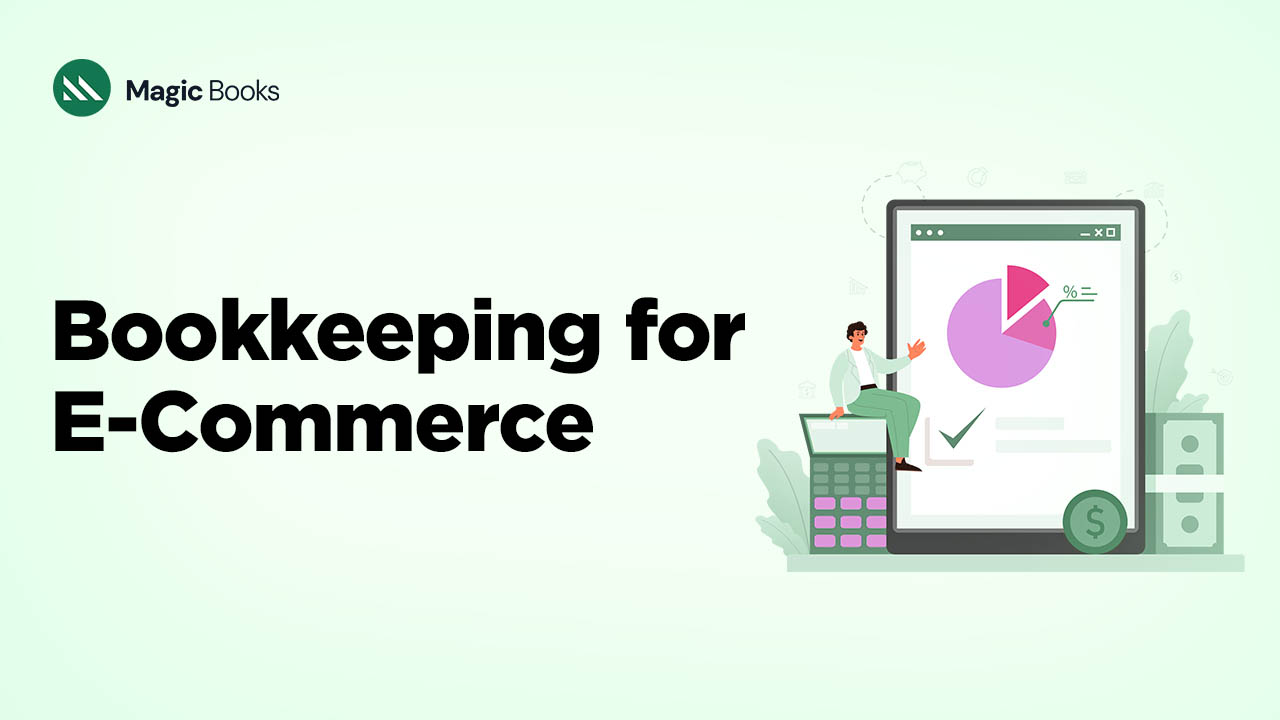E-commerce sales in the United States accounted for 15.9% of total retail sales in the first quarter of 2025, according to the U.S. Census Bureau. That’s nearly one in six dollars spent at retail. And if you’re running an online business, you already know the traditional bookkeeping playbook? Yeah, throw it out the window.
You’re managing sales across Amazon, your Shopify store, maybe eBay, dealing with payment processors that seem determined to confuse you, tracking inventory that’s probably sitting in three different warehouses, and somehow you’re supposed to navigate state tax rules that change faster than TikTok trends. Traditional bookkeeping is not going to suit it.
The digital marketplace is not showing signs of slowing down, which means more money to be made, sure, but also more ways to accidentally mess up your books. If you’re working with e-commerce clients and you don’t get bookkeeping , you’re doing them a disservice. These businesses live in a completely different world. Without solid bookkeeping, and we mean bulletproof, not just “good enough”, you’re basically gambling with your business. Tax time becomes this panicked scramble, you’re making decisions based on feelings instead of numbers, and when that big growth opportunity shows up? You won’t even know if you can afford to take it.
Why Accurate Bookkeeping Actually Matters for E-Commerce
Let’s get the scary stuff out of the way first: taxes. The IRS doesn’t care that your “office” is your kitchen table and your warehouse is a third-party fulfillment center. They want their paperwork, period. We’re talking gross receipts, purchase documentation, expense records. Keep ’em for three years minimum. Some stuff needs to stick around for seven. That’s a lot of digital file folders.
But here’s where online selling gets really tricky. Cash flow becomes this weird juggling act because payment processors are basically holding your money hostage. Stripe might hold funds for two days, PayPal for longer if they don’t like something about your account, and don’t get us started on what happens when chargebacks hit. You see “$15,000 in sales” on your dashboard and think you’re rich, but your actual bank balance? That’s telling a different story entirely.
Then there’s what we call the “profit mirage problem.” Happens to almost every new seller. Sales numbers look fantastic. You’re patting yourself on the back, maybe planning that vacation. Then reality smacks you in the face when you actually calculate platform fees (Amazon’s referral fees alone can be brutal), shipping costs that somehow doubled overnight, returns that pile up during holiday season, and all those tiny inventory adjustments that nobody warns you about. Suddenly those healthy margins disappear faster than free samples at Costco.
As your business grows, you’ll catch attention from banks when you apply for loans, potential investors if you’re thinking about scaling, maybe even buyers if you decide to sell. The Small Business Administration isn’t kidding around when they say organized records are your business insurance policy. When someone comes knocking with serious questions, you want answers ready, not a desperate search through three years of scattered Excel files.
Core Bookkeeping Tasks Every Online Seller Must Master
Recording sales sounds simple until you realize each platform has its own personality disorder. Shopify gives you clean gross numbers, Amazon shows net after they’ve taken their cut, eBay does something completely different, and that new marketplace you’re testing? They’ve invented their own special way of reporting that makes no sense to anyone.
The trick is building rock-solid procedures for capturing gross sales revenue while properly filing away those platform fees. Refunds and chargebacks is every seller’s least favorite topic. These aren’t just “oops, give the money back” situations. Refunds slice right through your gross sales for that period, while chargebacks come with penalty fees that hurt.
Payment processing fees average around 2.9% (which adds up frighteningly fast when you’re doing volume). Marketplace fees range anywhere from 3% to 15% depending on where you’re selling and what category you’re in. Amazon referral fees, eBay final value fees, Google Ads spending needs its own line item if you want to actually understand where your money’s going instead of just wondering where it went.
Shipping and cost of goods sold calculations is where things get genuinely messy. Multiple suppliers sending stuff from different locations, dropshipping arrangements that work until they don’t, freight costs that seem to follow their own logic. You need to track what the experts call “landed costs”, that’s your product cost plus inbound shipping plus customs duties plus whatever random handling fees appear out of nowhere. Meanwhile, shipping charges to customers count as revenue, but your actual shipping expenses live somewhere else entirely. Make sense? No? Welcome to e-commerce.
Inventory adjustments happen whether you plan for them or not. Damaged goods, returns you can’t resell (thanks, customer who apparently used our product as a chew toy), occasional theft, these realities need systematic documentation. Because if you can’t prove the loss to the IRS with paperwork, it never happened in their world.
Sales tax collection is like playing chess blindfolded. Different states, different rates, different rules for what’s even taxable in the first place. You need meticulous records of what you collected, what you actually sent to states, and any exemptions you applied. Miss something here, and you’ll get some very unpleasant mail from state revenue departments.
Payment processor reconciliation means matching daily sales reports to actual bank deposits while accounting for fees, holds, and timing differences that seem designed to drive you crazy. Credit cards, PayPal, Apple Pay, those buy-now-pay-later services that customers love, each one has its own reconciliation steps.
Bank deposits need to line up with specific sales batches and processor reports. One missing deposit or processing error throws your entire month into chaos. Automated tools help, but somebody still needs to babysit the whole operation.
Picking Your Accounting Method and Software (Without Losing Your Mind)
Cash versus accrual accounting, sounds like the world’s most boring decision, but it affects literally everything. Cash accounting is pretty simple: count money when it actually shows up in your account, count expenses when you actually pay them. Clean, straightforward, perfect for smaller operations that aren’t drowning in complexity.
Accrual accounting recognizes revenue when you earn it and expenses when you rack them up, regardless of when money actually changes hands. More complex? Absolutely. But it gives you a much clearer picture of what’s really happening with your business.
Most e-commerce businesses should probably lean toward accrual, and here’s why. Timing differences will drive you insane otherwise. You make a sale today, bought that inventory last month, payment processes tomorrow. Cash accounting can make a wildly profitable month look like a disaster simply because of when things happen. Plus, if you’re pulling in more than $27 million annually over three years, the IRS makes the choice for you, accrual or bust.
Software selection is where you separate the tools that actually work from the ones that look pretty in demos. You need marketplace integrations that genuinely function, not “we support Amazon” that requires three hours of manual data massage every single week. Look for direct connections to whatever platforms you’re using such as Shopify, Amazon, eBay, WooCommerce that import transactions without requiring a computer science degree.
Inventory support better be bulletproof. Perpetual tracking, cost layer management, automated cost of goods sold calculations, the whole nine yards. You want real-time visibility across multiple locations and channels that prevents the special kind of panic that comes from overselling and optimizes purchasing decisions.
Multi-channel support lets you maintain unified inventory records while tracking performance by platform. Consolidated reporting gives you the big picture while maintaining those detailed records that keep auditors happy and IRS agents at bay.
Handling Sales Tax and Marketplace Facilitator Rules (Finally, Some Good News)
Here’s actually some good news for once. Marketplace facilitator rules mean platforms like Amazon, eBay, and Etsy now handle most tax collection headaches for you. These laws shifted the burden from individual sellers to platforms when they meet certain criteria such as handling payments, fulfilling orders, providing customer service. Basically, if they’re acting like the middleman, they get to deal with the tax complexity too.
Every state with sales tax has jumped on this train, creating more uniform collection across platforms. But, and this is important, you’re still responsible for direct sales and platforms that don’t qualify as facilitators. So don’t get too comfortable.
Nexus rules determine where you actually need to collect and pay sales tax. Physical nexus is old school: got a warehouse, employee, or inventory sitting in a state? You’ve got nexus there. Economic nexus is the newer, trickier version, usually triggering at $100,000 in annual sales or 200 transactions. Course, thresholds vary by state because heaven forbid we make this simple.
Keep an eye on nexus thresholds across all your channels and states. Marketplace sales count toward those calculations even when platforms collect taxes directly. Miss a threshold, and you’re looking at back taxes, penalties, and some very unhappy conversations with accountants.
State revenue departments keep current information on their websites about tax rates, filing requirements, registration procedures. The Streamlined Sales Tax Project offers resources for multi-state compliance, while professional software providers maintain updated rate tables and filing capabilities that don’t require a law degree to understand.
Best Practices and Monthly Close Routines (That Won’t Drive You Crazy)
- Monthly reconciliation: Start by matching every single bank deposit to your payment processor reports and sales channel settlements. Sounds tedious? It absolutely is. But this grunt work catches missing deposits, processing hiccups, or those weird timing differences that can throw your entire month into chaos.
- Tax accrual calculations require you to play fortune teller with your income tax liabilities. You’re estimating based on year-to-date profits and whatever rates apply to your situation. E-commerce businesses with seasonal swings (hello, Q4 holiday rush) need to project annual income carefully to nail down appropriate quarterly payments. Miss this, and those underpayment penalties will bite harder than a hangry customer.
- Inventory review time: Its the monthly reality check nobody enjoys but everyone needs. You’re hunting for slow-moving items that are gathering dust, identifying damaged or obsolete stock that’s eating into your margins, and calculating write-downs that hurt but are necessary.
- Financial statement: The prep involves cranking out profit and loss statements, balance sheets, and cash flow reports for management review and professional consultation. But here’s the key, separate performance by sales channel. Amazon numbers, Shopify numbers, eBay numbers, all tracked separately so you can spot trends and make smart decisions instead of flying blind.
- Professional reporting for your advisors and accountants means providing detailed general ledger info, documentation for any weird transactions (and there’s always something weird), plus explanations for significant changes from prior periods or whatever budget targets you set. Make their lives easier, and they’ll return the favor when tax season rolls around.
When to Wave the White Flag and Get Professional Help
- Complex inventory management screams “get help” when you’re juggling inventory across multiple warehouses, managing dropshipping partners who sometimes flake, or handling customization and bundling that makes your brain hurt. These situations demand sophisticated cost accounting that’s light-years beyond basic bookkeeping. If you’re spending more time figuring out inventory costs than actually selling stuff, it’s time to call in reinforcements.
- Multi-state nexus obligations: This is where things get genuinely nightmarish. Different states, different rules, filing procedures that change without warning, calculation methods that seem designed by people who hate small business owners. Professional guidance is your survival insurance. When you’re dealing with multiple states whose rules contradict each other, you need someone who speaks fluent tax code.
- High transaction volume can drown even the most organized business owner. When your daily transaction counts start exceeding what your team can handle without working nights and weekends, outsourcing becomes a sanity-saving move. Sure, automated systems help manage the volume, but you still need professional oversight to catch the mistakes that slip through and ensure compliance with regulations that multiply like rabbits.
- Marketplace settlement complexity hits when you’re dealing with multiple payment processors, foreign currencies, or international transactions that involve customs procedures and tax obligations most people have never heard of. This stuff requires specialized expertise that typical small business accounting knowledge just doesn’t cover. If you find yourself Googling “foreign exchange accounting” at 2 AM, it’s probably time to hire someone who already knows the answers.
Where to Learn More (Resources That Actually Help)
Professional resources include authoritative guidance from federal agencies, professional organizations, and software providers that know what they’re talking about. The IRS provides comprehensive recordkeeping requirements and small business guidance through Publication 583 and online resources designed for business taxpayers.
State revenue departments offer specific guidance on sales tax obligations, marketplace facilitator rules, and nexus requirements through official websites and taxpayer education programs. The American Institute of CPAs provides professional guidance on accounting principles and best practices specifically for e-commerce businesses.
Software providers including QuickBooks, Magicbooks, and specialized e-commerce solutions offer educational resources, integration guides, and best practice recommendations for automated bookkeeping procedures and compliance management that actually work in the real world.



